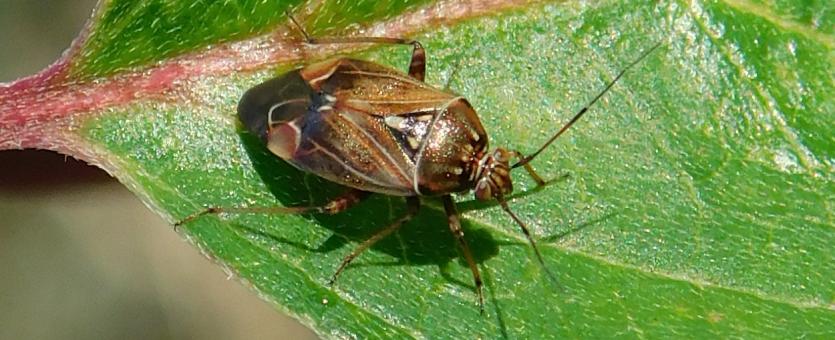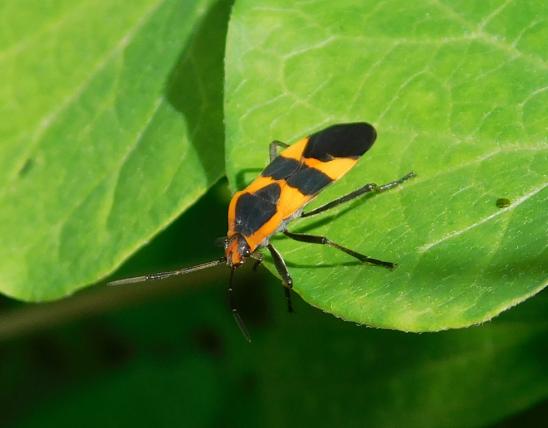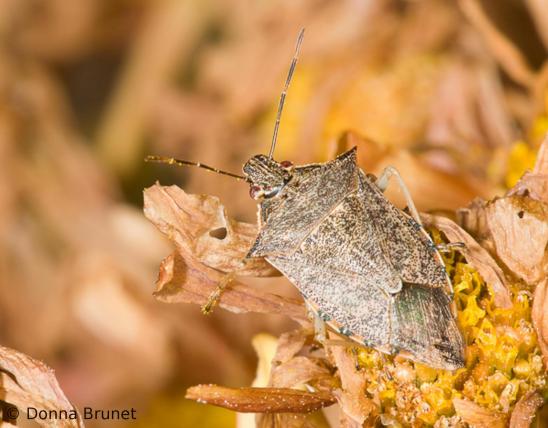
A huge, abundant family of true bugs, plant bugs, or mirids, are often overlooked — except by gardeners and farmers. Most mirids eat plants, and some are agricultural pests. As a group, they’re an important food source for birds and other insectivores.
In North America north of Mexico, there are about 2,000 species, in more than 220 genera, in this large, diverse family. Overall, the body shapes and sizes vary a lot, though most are small. Color ranges widely from drab, camouflaged browns, grays, greens, and tans to colorful reds, black-and-white patterns, and patterns of black plus red, orange, or yellow.
Most plant bugs are oval, but others are elongated. Many look something like seed bugs, assassin bugs, leaf-footed bugs, or scentless plant bugs (such as boxelder bugs). Some, however, look like ants; some look like lacewing bugs; some look like planthoppers or spittlebugs.
Browsing images of an array of common plant bugs can help you get an idea of what most of them look like. Here are some key identifiers. By themselves, these characters are not limited to the group, but together, they help you separate plant bugs from other families of true bugs.
- Usually seen on leaves or feeding on plants.
- Bodies oval or elongated, fairly soft.
- In many species, the shape of the prothorax (the shoulderlike plate behind the head) makes the head point downward, making the insect look somewhat humpbacked.
- The antennae are relatively long, thin, and delicate, with 4 segments.
- The legs are relatively long, thin, and delicate.
- The front wing has a special feature called a cuneus: on the thickened, basal part of the wing, there is a triangular, thickened section at its outer part, with a crease dividing the two portions.
- Also on the front wing, its outermost, membranous portion has 2 closed cells. That is, there are two sections on the membranous portion that are fully encircled by raised veins.
- Nearly all plant bugs lack ocelli. Ocelli are the very small, simple eyes that many insects have on their heads between the much larger, compound eyes.
- The feet (tarsi) almost always have 3 segments.
- The beak (rostrum), used for piercing and sucking plant juices, has 4 segments.
- To separate mirids from other families of true bugs, entomologists note specialized, elongated hairs (trichobothria) on the middle and hind legs of plant bugs. Trichobothria have a sensory function, something like a cat’s whiskers, for detecting air movements. Alas, you will probably need magnification to see these structures. But this is the only family of true bugs that has them.
Similar species: Considering the great diversity within this family, it can be tricky to distinguish them from other families of true bugs such as seed bugs, assassin bugs, stink bugs, leaf-footed bugs, scentless plant bugs (such as the boxelder bug), and others. Browse the images in BugGuide’s plant bugs pages to get a feel for the diversity of this group.
Adult length: most are less than ½ inch.
Statewide. The different species may have different distribution patterns.
Habitat and Conservation
As with other insects that feed primarily on plants, mirids are usually found near their host plants. Species that can feed from a wide array of plants are likely to be widespread and abundant. Species that are limited to only certain types of host plants will usually only be found near those plants.
Food
As with other members in the order of true bugs, plant bugs have strawlike mouthparts adapted for piercing and sucking juices. Most species of plant bugs feed on the juices and soft tissues of plants, usually taken from the leaves or stems. Some members of this family are predatory on other insects.
Some plant bugs are generalists and able to feed from a wide variety of plant types. Others, however, are limited to certain types of plants, so their fortunes are intertwined with those of their specific host plants. Some of the most well-known plant bugs are serious crop pests.
Many species of plant bugs are zoophytophagus — they primarily suck the juices of plants, but they may also eat other insects, as the opportunity arises. Some of these species are being studied as biocontrol agents against more serious agricultural pests.
Status
Plant bugs are the largest family of true bugs. Globally, there are more than 10,000 species and about 1,300 genera.
Many of the best-known species are serious agricultural pests. Some species transmit plant-disease viruses from plant to plant.
Several species of plant bugs prey on other insects, especially aphids, scales, and similar sap-suckers. Some of these are being studied as biocontrol agents to help reduce outbreaks of pest species in crop fields and orchards.
Life Cycle
Plant bugs, like other true bugs, undergo simple, or incomplete metamorphosis. After hatching from eggs, the immature stages look more or less like smaller versions of the adult stage, only without fully developed wings and (often) with different color patterns. Unlike beetles, butterflies, and other insects that undergo complete metamorphosis, they do not have grublike or caterpillar-like larval stages.
Human Connections
Several species of plant bugs are infamous crop pests, damaging food crops, fruit orchards, and cut-flower crops. The tarnished plant bug (Lygus lineolaris) (and its close relatives) will eat soybeans, cotton, alfalfa, strawberries, and more. It is the most common plant bug in the United States and feeds on more than half the species of plants cultivated in our country. Another pest is the two-spotted grass bug (Stenotus binotatus), an Old World species introduced to our continent; it eats grasses, including wheat, chemically damaging the grains.
Although several types of plant bugs are notorious agricultural pests, and others feed destructively on cultivated ornamental plants, a much wider majority of this group feed on wild plants and play a critical role in nature, as food for birds and other insectivores.
Many kinds of plant bugs eat other insects, and several of these are used as biocontrol agents for peskier pests. Here are a few examples in North America:
- Deraeocoris nebulosus, which deserves a common name, eats aphids, scale insects, whiteflies, psyllids, mites, and lace bugs, making it a valuable help for people trying to grow more than 50 species of orchard and ornamental shrubs and trees. One study showed adults eating 4–7 cotton aphids a day and 16–19 tobacco budworm eggs a day.
- Dicyphus hesperus, which also lacks a common name, eats a variety of pest insects, notably whiteflies that damage tomato plants, plus aphids, spider mites, thrips, and various caterpillars. It, however, must eat some plant juices to survive, so its populations may become pests if the prey insects are too few. Its favorite food plant is mullein.
A hot field in biology is plant-insect interactions. If you’re considering a career in the sciences, you could play a useful role in understanding the relationships between plants and insects. This can help agriculture and the environment, and there’s no end to the fascinating relationships between the insects that eat, lay eggs on, pollinate, and/or live on plants, and the plants that they use.
Ecosystem Connections
As herbivores, plant bugs consume plant juices and tissues, converting those nutrients into the form of their bodies. Insects are high-protein, nutritious foods for a wide range of insectivores. The respected ecologist E. O. Wilson called insects “the little things that run the world” because of their role in transmitting nutrients and calories from plants to animals that cannot eat plants directly. Many animals prey on the various plant bugs:
- Birds are especially notable, since nearly all bird species must capture a bounty of insects to raise their nestlings to adulthood. Ecologists put it quite simply: “no bugs, no birds.” A large reason for bird migration is their need for abundant insects during nesting season.
- Toads, frogs, salamanders, lizards, snakes, and turtles also eat insects, including plant bugs.
- Other insects and spiders consume plant bugs: mantids, robber flies, assassin bugs, dragonflies, and more.
- A plant bug that falls into the water may be eaten by fish or other aquatic predators.
Meanwhile, when plant bugs prey on aphids, mites, thrips, scale insects, and other small arthropods, they help limit the populations of those animals, preventing large outbreaks that could seriously damage populations of the food plants.
At least a few plant bugs appear to use bright red, orange, or yellow–plus–black color combinations as a defense against predators. These bold warning colors may truthfully advertise their toxicity or bad flavor, or they may fool predators into confusing them with insects that are toxic or bad-tasting.

































